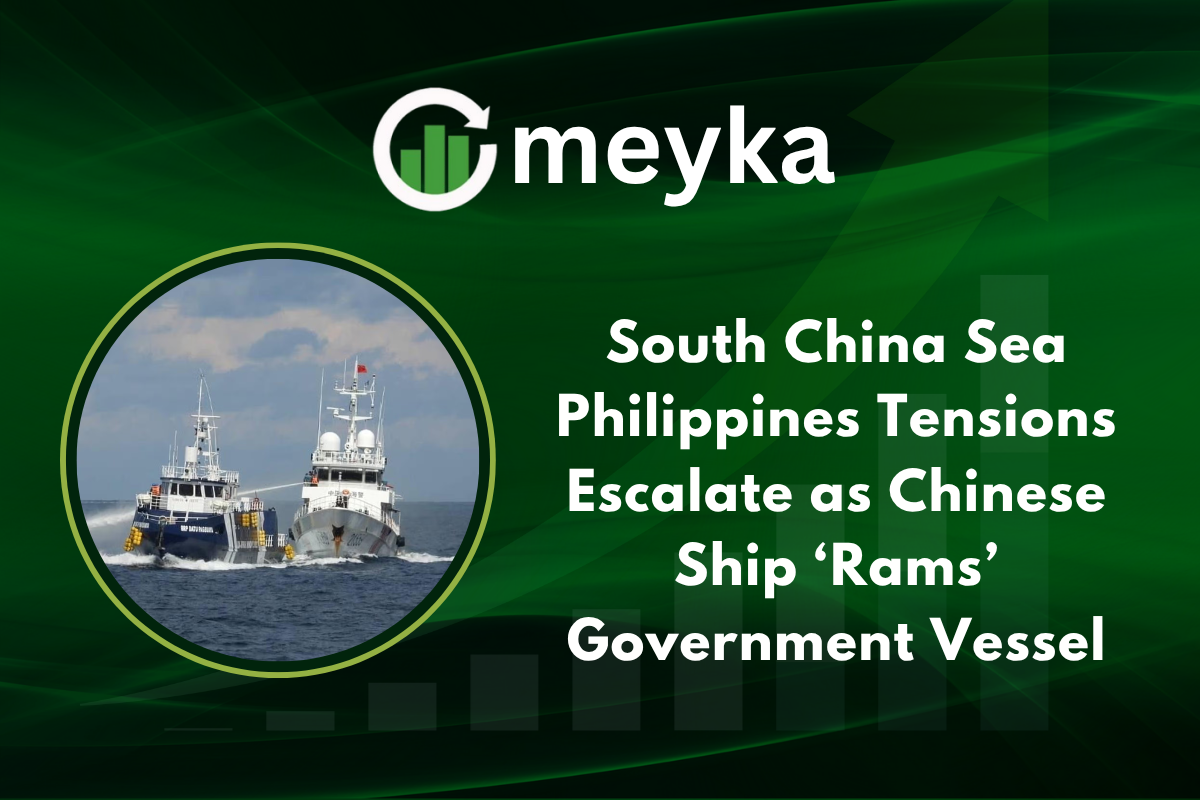South China Sea Philippines Tensions Escalate as Chinese Ship ‘Rams’ Government Vessel
Tensions in the South China Sea have surged again after a Chinese Coast Guard ship allegedly rammed a Philippine government vessel near Thitu Island on October 12, 2025. According to the Philippine Coast Guard, the ship BRP Datu Pagbuaya was conducting a routine resupply mission when it was struck by a larger Chinese vessel.
Manila condemned the act as “deliberate and dangerous,” while Beijing accused the Philippines of “trespassing.” The latest incident underscores how fragile peace remains in one of the world’s busiest and most disputed waterways.
Why did this clash happen now, and what does it mean for regional stability?
What Happened in the South China Sea
A collision that raised an alarm
Philippine officials released video footage showing a Chinese ship firing water cannons before hitting the side of the Datu Pagbuaya. The incident took place within what Manila considers its exclusive economic zone, just 14 nautical miles from Thitu Island.
The Philippine Coast Guard said the crew escaped unharmed, though the vessel sustained visible damage. Chinese authorities, however, argued that the Philippine vessel “intruded” into what they claim as Chinese waters.
You can watch verified footage of the encounter, showing how dangerously close the two ships came before impact.
Why are these waters so contested?
The South China Sea and Its Strategic Importance
The South China Sea is one of the world’s most crucial maritime corridors. It carries nearly $3.5 trillion in annual trade and holds rich fishing grounds and potential energy reserves. Several countries, including the Philippines, China, Vietnam, Malaysia, and Brunei, have overlapping territorial claims.
China claims nearly the entire sea under its “nine-dash line,” a claim invalidated by a 2016 Hague Tribunal ruling, which sided with the Philippines. Beijing, however, has continued to fortify artificial islands and patrol contested zones.
Could this collision reignite old disputes?
Reactions from Manila and Beijing
Philippines: “A clear act of aggression”
The Philippine Department of Foreign Affairs condemned the collision, calling it “an act of aggression and intimidation.” President Ferdinand Marcos Jr. vowed to continue asserting the nation’s rights under international maritime law.
A video statement shared on social media by local journalists quickly gained attention. One viral post captured the outrage of Filipino netizens who demanded stronger action, see this tweet for public reaction trending under #WestPHSea.
How did Beijing respond?
China: “The Philippines provoked this.”
In a sharply worded statement, China’s Ministry of Foreign Affairs said the Philippine ship “illegally entered Chinese waters.” Beijing claimed its coast guard acted with “professional restraint” to block what it viewed as a violation of sovereignty.
The Chinese state outlet People’s Daily shared the official narrative through its verified account, read the official post here, emphasizing that China “has indisputable sovereignty” over the waters in question.
Global and Regional Reactions
US, ASEAN, and the UN weigh in
Washington condemned the ramming incident, reaffirming that the US-Philippines Mutual Defense Treaty covers attacks on Philippine vessels. A spokesperson from the US State Department called China’s actions “reckless and destabilizing.”
ASEAN countries expressed concern and urged both sides to “exercise maximum restraint.” Meanwhile, the United Nations called for a return to dialogue to prevent “accidental escalation.”
A Southeast Asia defense analyst shared her take on social media, noting that “each encounter in the South China Sea risks becoming a flashpoint.” Her commentary was amplified widely, see this tweet for the expert analysis that captured global attention.
Could this spark a military standoff?
The Long Shadow of Past Disputes
From Scarborough to Thitu: a pattern of pressure
The South China Sea has seen similar confrontations before. In 2012, Chinese and Philippine ships faced off at Scarborough Shoal, leading to years of tension. Since then, Chinese coast guard vessels have frequently shadowed or blocked Philippine resupply missions to outposts in the Spratly Islands.
According to defense experts quoted by The Guardian and Reuters, China’s tactics appear aimed at asserting control through “gray zone” pressure, actions short of open warfare but designed to wear down opponents.
To understand how these encounters fit into broader regional politics, watch this in-depth analysis from DW News explaining China’s long-term maritime strategy.
The Human Side of the South China Sea Conflict
Fishermen caught in the crossfire
For Filipino fishermen, these disputes are not abstract politics; they are daily realities. Many report being chased, blocked, or intimidated by Chinese vessels when trying to fish near traditional grounds.
A viral post by a Filipino fisherman’s group described how local livelihoods are being crushed by the growing militarization at sea. Their message, shared by an advocacy page, resonated with thousands. View it here to see the emotional side of the story.
Why can’t diplomacy solve this crisis?
Diplomatic and Military Implications
Calls for calm and international mediation
Philippine officials said they are filing a new diplomatic protest with Beijing, while exploring possible international arbitration or ASEAN-backed mediation. Analysts say the challenge lies in balancing deterrence and diplomacy.
The Chinese Coast Guard has increased patrols, and the Philippine Navy has begun coordinating more closely with the US and Japanese maritime forces. The region risks entering a cycle of tit-for-tat patrols that could raise the odds of an accident or miscalculation.
Strategic analysts told Reuters that this latest episode may prompt the Philippines to request joint patrols with allied navies, a move Beijing would likely view as provocation.
Could open confrontation be avoided?
Broader Context: The Battle for Influence in the South China Sea
Experts believe the collision underscores the shifting balance of power in Asia’s maritime sphere. The South China Sea has become a litmus test for how China projects authority and how smaller nations respond.
According to geopolitical observers, Beijing’s goal is to normalize its presence and reduce external resistance. Meanwhile, countries like the Philippines are rallying international support to preserve navigation rights and territorial integrity.
Conclusion
The South China Sea remains a flashpoint where nationalism, geopolitics, and livelihoods collide. The ramming of a Philippine vessel by a Chinese ship is the latest chapter in a long story of contested claims and uneasy diplomacy.
While leaders in Manila and Beijing both call for restraint, the underlying tensions continue to deepen. The world’s attention now turns to whether these nations can prevent another confrontation, one that could reshape the regional order and test global peacekeeping efforts.
As one analyst noted, “The South China Sea is calm only on the surface. Beneath it, a storm is always brewing.”
FAQ’S
According to officials, a Chinese Coast Guard vessel rammed a Philippine government ship near Thitu Island during a resupply mission. People believe it shows China’s growing assertiveness, while Google’s view highlights it as part of broader maritime disputes and power projection in Asia.
The South China Sea is one of the busiest trade routes in the world, rich in oil, gas, and fisheries. People emphasize its economic value, while Google’s insights note its importance for global shipping lanes and regional security.
The Philippines called it a “deliberate act of aggression,” while China said it was defending its sovereignty. According to people online, tensions could escalate fast; Google’s summaries show both sides are using diplomatic channels but remain firm on their claims.
The U.S. supports the Philippines under their mutual defense treaty and often conducts freedom of navigation patrols. People see Washington as Manila’s main ally, while Google interprets the U.S. role as maintaining a balance of power and deterring Chinese expansion.
Fishermen say they face harassment and reduced access to traditional fishing areas. People express sympathy for their struggle, and Google’s perspective frames it as a humanitarian issue within a larger geopolitical standoff.
Analysts predict more diplomatic protests and joint patrols with allied navies. People fear possible military escalation, while Google trends point toward increased international attention and pressure for peaceful resolution.
Disclaimer
This content is made for learning only. It is not meant to give financial advice. Always check the facts yourself. Financial decisions need detailed research.






